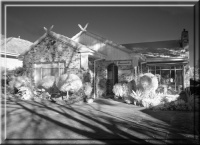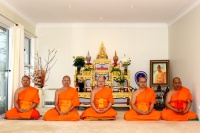Wat Thai Nakorn
| Wat Thai Nakorn | |
|---|---|
| Information | |
| Tradition/Linage | Thai |
| Main School | Theravada |
| Founded | Founded(when)::1984 |
| People | |
| President(s) | BUORG-Names::Names::Phra Khru Kampeepanyawithet (Boonsom Uttan) |
| Teacher(s) | BUORG-Names::Names::Venerable Ajahn Somwang |
| Contact Infotmation | |
| Address | 489 Elgar Road Box Hill Victoria 3128 Australia |
| Country | Australia |
| Coordinates | service=google }} {{#geocode:489Elgar RoadBox HillVictoriaAustralia|format=float|service=google}} service=google }}The "_geo" type of this property is invalid |
| Map | {{#display_map:{{#geocode:489Elgar RoadBox HillVictoriaAustralia}}|height=250px|width=250px|zoom=18}} |
| Phone | Phone::(03) 9899 0883 |
| Website | Website::http://www.watthaimelbourne.com.au/?type=home "Website" has not been listed as valid URI scheme. |
| Email::watthaimelbourne@gmail.comURIs of the form "Email::watthaimelbourne@gmail.com" are not allowed. | |
Wat Thai Nakorn
The History
In Thailand in the early 1980s His Holiness Somdet Phra Buddhakosajarn, Wat Samphraya inquired of His Holiness Phra Dhammakunaporn (Paiboon) (Pali IX) about his frequent overseas travels and whether he planned to promote the Thai Buddhist teachings during his travels abroad or if he had considered building a temple overseas as means of promoting Thai Buddhism to those countries.
His Holiness Phra Dhammakunaporn (Paiboon), considered the great vision of His Holiness Somdet Phra Buddhakosajarn, and felt that there would be undeniable benefits for the teaching and promoting of Buddhism to Buddhists abroad as well as reaching out to people who wished to know more about Buddhism. He was reminded of the history of the third reformation, and thought; What if the great King Asoka had not decided to approve and send a number of disciples to travel and to teach the way of Buddhism. If this was the case then it is possible that today we would not have gained the knowledge of wisdom or enlightenment of Dhamma.
From the wise reasoning of His Holiness Somdet Phra Buddhakosajarn as mentioned earlier, His Holiness Phra Dhammakunaporn recognized that this initiative would be a great benefit for the promotion and teaching of Buddhism, and saw it as a duty of Thai monks to carry out this important work. He promptly agreed to this strategy.
His Holiness had been informed that Thai monks had traveled and settled around the world for promoting and teaching Buddhism, especially in Europe and the United States of America. Australia however, had only a few Thai monks who had been settled. Australia was seen as a country with boundless land and a thriving, prosperous Thai community. There was also other Asian Buddhists who had settled here in Australia. He realized that to accomplish his objective he needed strong support from the local Thai community who believed in, and had faith in Buddha to assist in the establishment of this mission. He made arrangements to convey the Buddhist teachings to Australia straight away.
From the deliberation of the following Holiness committee of Mahanikaya sect.
- His Holiness Somdet Phra Buddhakosajarn, (Acting the Sangha Supreme Council), the abbot of Wat Samphraya, Bangkok as the president of temple assemble.
- Phra Thammateeraratchamuni, (Ecclesiastical Regional Governor 7) the abbot of Wat Paknam Pasrichareon, Bangkok as the vice president of temple assemble.
- Phra Thepmunee, (Deputy Ecclesiastical Regional Governor 1) the abbots of Wat Don Yannawa, Bangkok as the committee of temple assemble.
- Phra DhepPanyasutee, (Ecclesiastical Provincial Governor Karnchanaburi) the abbot of Wat Chaichumpol Chanasongkram, Karnchanaburi, as the committee of temple assemble implementator.
- Phra Rajpariyathsuthee (Deputy Ecclesiastical Provincial Governnor Suphanburi), Wat Donjedee Supanburi, as the temple assemble
In 1984, His Holiness Phra Dhammakunaporn, organized an excursion comprising of 12 senior monks from Thailand to Australia for the prospect of promoting and teaching Buddhism in Australia. After receiving positive and encouraging feed back from this excursion, it was decided to establish the preliminary Thai temple in Melbourne, Victoria. This was achieved with the co-operation and assistance from Narongsak Chanmeesri, The president of Thai Association of Victoria, Peeti Suwannasara and the other Thai people. His holiness Phra Dhammakunaporn proceeded to seek permission from The Supreme Council of Administration to endorse the appointment of Dr.Phra Maha Chamrus Wiriyanantho from Wat Ratchanadda, Bangkok to stay in the initial temple venue at 1 Head Street Balwyn Vic 3103.
We moved to another buiding by renting a premises,the entrance of which was at the rear of 281 Doncaster Rd. North Balwyn, 3104. On the 20 November 1986 the committee agreed to purchase the present Temple venue at 489 Elgar Road Box Hill, Melbourne Victoria, at the price of AU $ 95,000 and have resided in the current venue since 12 February 1987. Most of the initial funds for the current temple were raised from Thailand to establish monks and promote Thai Buddhism in Australia.
On 19 May 1987, the temple was registered as a Non-profit organization as The Melbourne Thai Buddhist Temple Inc. (Wat Thai Nakorn Melbourne).
What is Buddhism?
For more than 2,500 years, the religion we know today as Buddhism has been the primary inspiration behind many successful civilizations, the source of great cultural achievements and a lasting and meaningful guide to the very purpose of life for millions of people. Today, large numbers of men and women from diverse backgrounds throughout our world are following the Teachings of the Buddha. So who was the Buddha and what are His Teachings?
The Buddha
The man who was to become the Buddha was born Siddhattha Gotama around 2,600 years ago as a Prince of a small territory near what is now the Indian - Nepalese border. Though he was raised in splendid comfort, enjoying aristocratic status, no amount of material pleasure could satisfy the inquiring and philosophic nature of the young man. At the age of 29 he left palace and family to search for a deeper meaning in the secluded forests and remote mountains of North-East India. He studied under the wisest religious teachers and philosophers of his time, learning all they had to offer, but he found it was not enough. He then struggled alone with the path of self-mortification, taking that practice to the extremes of asceticism, but still to no avail.
Then, at the age of 35, on the full moon night of May, he sat beneath the branches of what is now known as the Bodhi Tree, in a secluded grove by the banks of the river Neranjara, and developed his mind in deep but luminous, tranquil meditation. Using the extraordinary clarity of such a mind with its sharp penetrative power generated by states of deep inner stillness, he turned his attention to investigate upon the hidden meanings of mind, universe and life. Thus he gained the supreme Enlightenment experience and from that time on he was known as the Buddha. His Enlightenment consisted of the most profound and all-embracing insight into the nature of mind and all phenomena. This Enlightenment was not a revelation from some divine being, but a discovery made by Himself and based on the deepest level of meditation and the clearest experience of the mind. It meant that He was no longer subject to craving, ill will and delusion but was free from their shackles, having attained the complete ending of all forms of inner suffering and acquired unshakeable peace.


